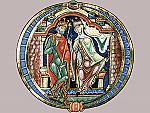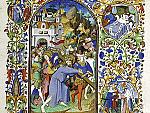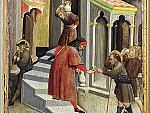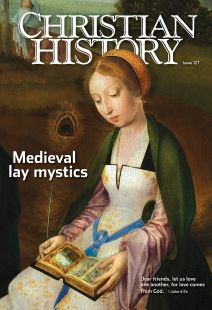A spiritual awakening for the laity
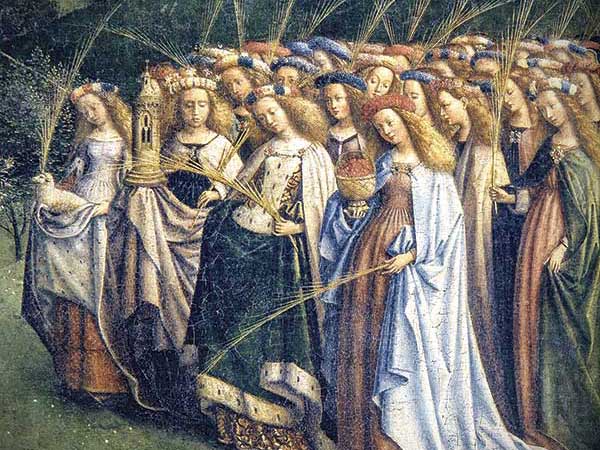
[15th-c. altarpiece shows female virgins and martyrs worshiping Christ the Lamb in heaven.]
FOR HUNDREDS OF YEARS in the Middle Ages, common people labored long hours to earn little, unable to read or write. Local priests were often illiterate as well, and sermons were few. Copies of the Scriptures were virtually unavailable, except in church. While monks and nuns had access to education and the Bible, the vast majority of the laity had neither.
All of this began to change, however, in the twelfth century—a change that can only be explained as a fresh move of God’s Spirit. Devout monks and hermits came out of seclusion and began to preach in towns and villages across Europe. Proclaiming the gospel in vernacular languages so that common people could understand it, they called laypeople and clergy to repent and enter a genuine relationship with the Lord—ultimately leading toward intimate oneness with Christ. This spiritual progress culminating in inner, mystical union became known as mysticism.
First by the thousands, then by the tens of thousands, laypeople responded to the gospel. Thirsty for a vital Christian life, they joined various movements within the church that offered them the opportunity to grow spiritually. This led to 300 years of remarkable waves of spiritual renewal across Western Europe, spanning from roughly 1200 to 1500.
radical brides of Christ
One of the key centers of this spiritual vitality was northwestern Europe, encompassing present-day Belgium, the Netherlands, France, Germany, and northern Switzerland. These lands witnessed three centuries of unprecedented spiritual flourishing. In fact the Rhine River, which flows through the heart of this part of the continent, experienced such revival that it became known as the “spiritual artery of the German people.”
Although many groups were part of this renewal, three key lay movements particularly flooded these territories along the Rhine: Beguines in the thirteenth century, Friends of God in the fourteenth, and Brothers and Sisters of the Common Life in the fifteenth.
First, the Beguines. Responding to itinerant preachers just before the year 1200, women by the thousands gave their lives to Christ and flocked into various convents. Soon, however, overflowing convents could hold no more newcomers. At that point many laywomen from towns in the Lowlands and Germany started something new; they joined together to form their own communities for spiritual growth. Pooling their resources they purchased large houses as well as copies of the Scriptures.
Known as Beguines, these women formed small households of widows and single women. During the early years, married women also joined the community for study, Scripture reading, and prayer during the day, returning to their families in the evening.
Some scholars believe the name “Beguine” derived from a word for “beige,” as the women wore plain-colored, simple clothes. Others think it may have come from “to babble,” since the women were known to do open-air preaching. Whatever its origin, it was originally a pejorative. Townspeople did not know what to make of these laywomen who lived together in Christian community but took no formal vows to become nuns.
A few of the early Beguines had independent financial means, but most women who joined the movement worked with their hands to support themselves. Some served as nannies for the wealthier citizens of the town; others started schools for girls. The majority worked in the booming Lowlands textile industry. Because many processes related to cloth required ample water, the majority of the beguinages (as their houses were called) were built on the edge of the city walls along streams or rivers.
As well as supporting themselves, the Beguines sought to earn enough money so they could give to the poor and infirm in the cities. Some gave of their meager incomes; others gave of their time, serving as nurses in leper houses or city infirmaries. Indeed some of the first beguinages formed around newly founded infirmaries. Christian women serving as nurses would simply organize themselves as a Beguine community.
spinning and studying
Because some of these women had basic education in their local languages, they were able to read and study the Bible, which was then (several centuries before Luther) being translated into Middle German, Dutch, and French. The church allowed these translations of the Bible for laypeople to use for their own devotional reading, as well as for evangelistic preaching and exhorting others to follow a godly lifestyle.
After meeting corporately in the morning for prayer, Beguines returned to their rooms where they spun and sewed in solitude while meditating on Scripture throughout the day. Not only did Beguines read the Bible and spiritual works that had been translated into the vernacular, they also wrote their own devotional books. In fact many of the earliest vernacular Dutch and German works came from the Beguines. Of these authors two remarkable women stand out (see "Everyone a Bride of Christ," p. 10): Hadewijch from Brabant (d. 1248) and Mechthild of Magdeburg (c. 1207–c. 1282).
The Beguines received verbal support from the papacy in 1215 and formal approval from Pope Gregory IX in 1233. Over the next few years, Countess Johanna of Flanders and Hainaut and her sister Margaret donated substantial funds to establish nearly a dozen very large Beguine complexes.
These Begijnhoven, as they were called in Flemish, became walled-off sections of town for the safety of the women living there. Some complexes had narrow winding cobblestone streets, just like the town. Others were built around a large open courtyard that could be several acres in size. It served as a common garden, supplying the women with grains, vegetables, and herbs.
During the next half-century, over 60 Beguine complexes with more than 100 women each sprang up across Belgium. Some housed more than 500. In Germany, the Lowlands, and northern France, women who committed their lives to God in this fashion numbered in the tens of thousands.
Beguines always remained laywomen. As long as they lived in the beguinage, they committed themselves to chastity and obeyed the community’s leadership. However they never took permanent vows and were always free to leave if they chose to marry. Likewise women owned their own property in the beguinage. Often sisters and cousins and aunts would pool their resources to purchase one of the townhomes in the community. Those who chose to leave the beguinage forfeited their property, which reverted to the community as a whole.
Thus Beguines bridged the gap between the “active” life of laywomen and what was referred to as the “religious” life of nuns. As they supported themselves and served the sick and needy in their towns, the Beguines intentionally lived in community with like-minded believers; praying together, studying Scripture, and reading devotional works in their common language. Radically in love with Jesus, these women saw themselves as brides of Christ and gave their lives to the pursuit of the Lord and service to him.
god’s friends
The fourteenth century saw a further spread of mysticism through people from many walks of life. Laymen and laywomen in towns and villages across Europe sought to come into the closest possible union with God. A number of factors contributed to this fresh wave of renewal. Laypeople were more and more able to obtain a basic education and to read Scripture and devotional works on their own. With the increase of trade, townspeople prospered enough to afford Bibles or portions thereof; meanwhile the Bible was being translated into many new Western European languages, making it more accessible than ever before.
Townspeople also had more leisure from manual work to read and cultivate a life of prayer. At the same time, significant crises marked the era: the devastating spread of the bubonic plague, peasant uprisings, and political unrest may have spurred people of all classes to seek God in an unprecedented way.
In the German-speaking territories, a loose association of devout Christians, known as the Gottesfreunde (Friends of God), began to form. Taking their name from several passages in Scripture referring to believers as God’s friends, the movement consisted of pockets of laypeople, Beguines, nuns, priests, and traveling Dominican preachers (from the order founded by Dominic of Caleruega in 1216).
Laypeople and those belonging to religious orders alike wanted to move deeper in their relationship with God and experience mystical union with him, as much as possible in this life. A network emerged; people kept in contact via mail, by visits, and through key traveling preachers. Amazingly the laity were part of this spiritual conversation, held to be on a par with men and women who had taken religious vows.
Two centers of the Friends of God were Basel in Switzerland and the free city of Strasbourg (now in France), both along the Rhine River. One of the lead figures in Basel was priest Henry of Nördlingen (d. 14th c.), who traveled and preached around Basel and across southern Germany.
In his preaching, spiritual direction, and friendships, Henry sought to draw others closer to Christ and to experience deeper oneness with the Lord. He carried letters from enclave to enclave among the Friends of God. At one point he secured a copy of Mechthild of Magdeburg’s Flowing Light of the Godhead (written c. 1250–1280) and helped to translate it into a southern German dialect as a resource for the Friends of God.
Four steps to holiness
Into this milieu of spiritual renewal came the great preacher Johannes Tauler (c. 1300–1361). As a Dominican friar, he heard confessions, provided spiritual direction, preached, and offered the Eucharist to Dominican nuns around his native Strasbourg. He did the same for households of Beguines and lay audiences, especially in Cologne. From 1338 to 1343, Tauler and his fellow Dominican preachers were exiled from Strasbourg and went to Basel. Already famous, Tauler became even better known as he connected with Henry of Nördlingen and the Friends of God in the area.
Tauler affirmed that all Christians are called to grow spiritually and that laypeople who take marriage vows can progress as far as those who take religious vows. Additionally he called all to read Scripture and meditate on it. Tauler continually exhorted his hearers to live out what they believed. “There is a great difference between those who live the Scriptures,” he preached, “and those who only read them.”
Throughout his sermons Tauler called people to become more holy. His guidance for spiritual formation could be summarized in four overarching movements; no matter what stage an individual might be in, he invited him or her to move to the next step.
First, if we are to draw close to God, we must become detached from temporal things. We are inclined to cling to three kinds of created things: material possessions, other people, and self-will. As long as our hearts are full of these, there is no room for the Lord. Quoting Saint Augustine, Tauler exhorted: “Empty yourself, so that you can be filled!”
The problem is that, by our own power, we cannot let go of these things. So, Tauler argued, God frees us from our clinging by bringing hardship into our lives; trials develop character, as Paul asserts in Romans 5. Tauler criticized monks and nuns who tried to beat their bodies into submission through severe fasting, all-night prayer vigils, and the like. Rather, he thought, God himself brings into each life enough struggle.
In sermons Tauler emphasized his second point: the trials that laypeople face and the daily challenges of life are opportunities. Some “poor people” in a given village, Tauler asserted, advance a hundred times further in their faith than those in religious orders by “shoveling manure and earning their bread by hard, bitter work.”
Third, Tauler said, we must embrace whatever suffering God sends, whether mistreatment or physical ailment. When the suffering is great, it can become a dark night where we wonder where God has gone. However, he assured, God is at work in us. We can yield completely to the Almighty. In this Gelassenheit (surrendered-ness), our hearts become at peace, even in the midst of affliction. Here we “count it all joy” as we encounter the various trials of life (James 1:2–4).
Finally, he said, the Lord brings us safely to the other side of the great darkness and long desert. There we experience oneness with God—mystical union—as never before. Because we have been made “open, receptive, and free” by God’s painful work in our lives, we are able to be filled with the fullness of God.
A retreat center and nine rocks
Upon Tauler’s death in 1361, Rulman Merswin (c. 1307–1382) and his wife, Gertrude, rose to leadership among the Friends of God in Germany. A wealthy banker in Strasbourg, Merswin had become part of the Gottesfreunde under Tauler, who helped direct Merswin away from severe asceticism. Merswin also described being influenced by a great “Friend of God from the Highlands”; many historians think this was a fictional persona Merswin used to write some of his own works.
Merswin emphasized the progression necessary for spiritual maturation. In his most influential work, Book of the Nine Rocks, he described what he saw to be nine stages of spiritual growth, culminating in union with Christ. He highlighted the fact that laypeople can move toward union with Christ in this lifetime just as much as those who had taken religious vows.
The Merswins purchased an abandoned convent on an island in the Ill River that flowed through Strasbourg. They restored it and established it as a center for the Friends of God, envisioning a place of retreat and contemplation. They placed it under the care of the Knights of Saint John, but little came of it after the Merswins passed away.
The Friends of God movement produced other famous devotional material. Meister Eckhart (c. 1260–c. 1328) preceded the movement, but his sermons and treatises laid the foundation for many of its emphases. Henry Suso (1295–1366), a contemporary of Tauler and fellow Dominican preacher, wrote several works; his Little Book of Eternal Wisdom (1328–1330) and its modified Latin version, the Clock of Wisdom (1334–1337), became among the most published medieval works on spiritual formation.
In addition the anonymous work Theologia Germanica (German Theology) of the late fourteenth century came out of the Friends of God. This was not a systematic theology, but rather a work on spiritual progress and mystical union with God, built upon the writings of early sixth-century author Pseudo-Dionysius (see “Like and unlike God,” pp. 14–16).
These works would influence even more laypeople in the fifteenth century among the followers of Geert de Groote (1340–1384), a Paris-trained theologian who converted to Christianity in 1374. He served as a preacher in the diocese of Utrecht, calling people—especially clergy—to a godly lifestyle. Because many priests maintained “housekeepers” (actually mistresses), de Groote’s message was not well received, and his license to preach was revoked in 1383. The following year, at age 40, he died of the bubonic plague.
a common life and a common purse
Before his untimely death, however, he lit the fire of a third new renewal movement, the Devotio Moderna. This renewal included households of laymen and laywomen called the Brothers and Sisters of the Common Life, as well as convents of nuns and monks. Much like the Beguines, the Brothers and Sisters were laypeople who sought to live deeper spiritual lives. Taking no permanent vows, they committed themselves to godly living, daily prayer, and Bible reading. Unlike the Beguines, they owned no private property. Each single-sex household maintained a common purse, and all income from their work went to sustain their houses and provide the necessities of life.
In the women’s homes, Sisters worked at making lace and cloth as well as at other forms of manual labor, such as brewing beer and copying texts. The Brothers’ main employment was copying devotional books. They produced hand-made copies of works of the church fathers, Christian classics, and vernacular translations of the Bible.
This work provided spiritual reading for their households, spread renewal across northern Europe, and provided adequate income. After the invention of the printing press in 1453, the Brothers printed Bibles and spiritual works, publishing an amazing threequarters of all devotional works printed in the last quarter of the fifteenth century. One, The Imitation of Christ, has become one of the most widely read books of all time. (Learn more in "Imitating Christ," pp. 24–28 of this issue, and in CH #116, 25 Writings that Changed the Church and the World.)
In time the Brothers began orphanages and schools for boys, teaching them the Bible and forming their Christian character. Two boys who received such an education were Desiderius Erasmus (1466–1536) and Martin Luther (1483–1546)—who would soon help to reach even more laity across Europe with the concept of a personal and transformative relationship with God.
Luther was also personally influenced by Tauler’s sermons, receiving encouragement during dark times. He published several editions of the Theologia Germanica, making this devotional work available across Germany during the Reformation.
Both Protestants and Roman Catholics have appreciated these three waves of spiritual renewal. These mystics’ invitation—especially to laity—to enter a deeper personal oneness with Christ resounds still in our day. CH
By Glenn E. Myers
[Christian History originally published this article in Christian History Issue #127 in 2018]
Glenn E. Myers is professor of church history and theological studies at Crown College and the author of Seeking Spiritual Intimacy: Journeying Deeper with Medieval Women of Faith as well as articles on mysticism in the Dictionary of Christian Spirituality and elsewhere.Next articles
Mystic women’s voices in the Middle Ages
Women outnumbered men in medieval mysticism.
Elizabeth Alvilda PetroffLike and unlike God
Much medieval mysticism had an unlikely source: the writings of an anonymous monk.
Edwin Woodruff TaitSeeing Christ crucified in her soul
Margery Kempe’s story gives us a window into the daily lives of many devout medieval people.
Joseph LynchSupport us
Christian History Institute (CHI) is a non-profit Pennsylvania corporation founded in 1982. Your donations support the continuation of this ministry
Donate



